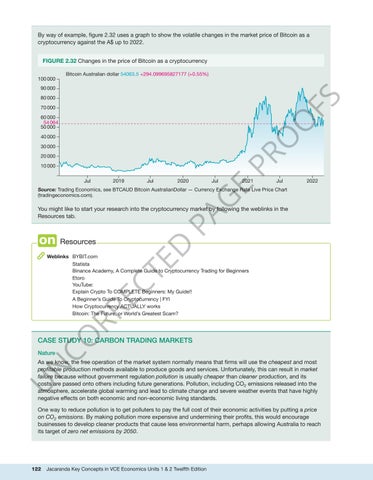“c02DecisionMakingInMarkets_PrintPDF” — 2022/5/25 — 13:13 — page 122 — #56
By way of example, figure 2.32 uses a graph to show the volatile changes in the market price of Bitcoin as a cryptocurrency against the A$ up to 2022. FIGURE 2.32 Changes in the price of Bitcoin as a cryptocurrency Bitcoin Australian dollar 54063.5 +294.099695827177 (+0.55%) 100 000 90 000
FS
80 000 70 000
O
60 000 54 064 50 000
O
40 000
PR
30 000 20 000 10 000 2019
Jul
2020
Jul
2021
Jul
2022
E
Jul
G
Source: Trading Economics, see BTCAUD Bitcoin AustralianDollar — Currency Exchange Rate Live Price Chart (tradingeconomics.com).
Resources
Resourceseses
D
PA
You might like to start your research into the cryptocurrency market by following the weblinks in the Resources tab.
CO RR EC
TE
Weblinks BYBIT.com Statista Binance Academy, A Complete Guide to Cryptocurrency Trading for Beginners Etoro YouTube: Explain Crypto To COMPLETE Beginners: My Guide!! A Beginner’s Guide To Cryptocurrency | FYI How Cryptocurrency ACTUALLY works Bitcoin: The Future, or World’s Greatest Scam?
CASE STUDY 10: CARBON TRADING MARKETS Nature
U
N
As we know, the free operation of the market system normally means that firms will use the cheapest and most profitable production methods available to produce goods and services. Unfortunately, this can result in market failure because without government regulation pollution is usually cheaper than cleaner production, and its costs are passed onto others including future generations. Pollution, including CO2 emissions released into the atmosphere, accelerate global warming and lead to climate change and severe weather events that have highly negative effects on both economic and non-economic living standards. One way to reduce pollution is to get polluters to pay the full cost of their economic activities by putting a price on CO2 emissions. By making pollution more expensive and undermining their profits, this would encourage businesses to develop cleaner products that cause less environmental harm, perhaps allowing Australia to reach its target of zero net emissions by 2050.
122
Jacaranda Key Concepts in VCE Economics Units 1 & 2 Twelfth Edition





















































